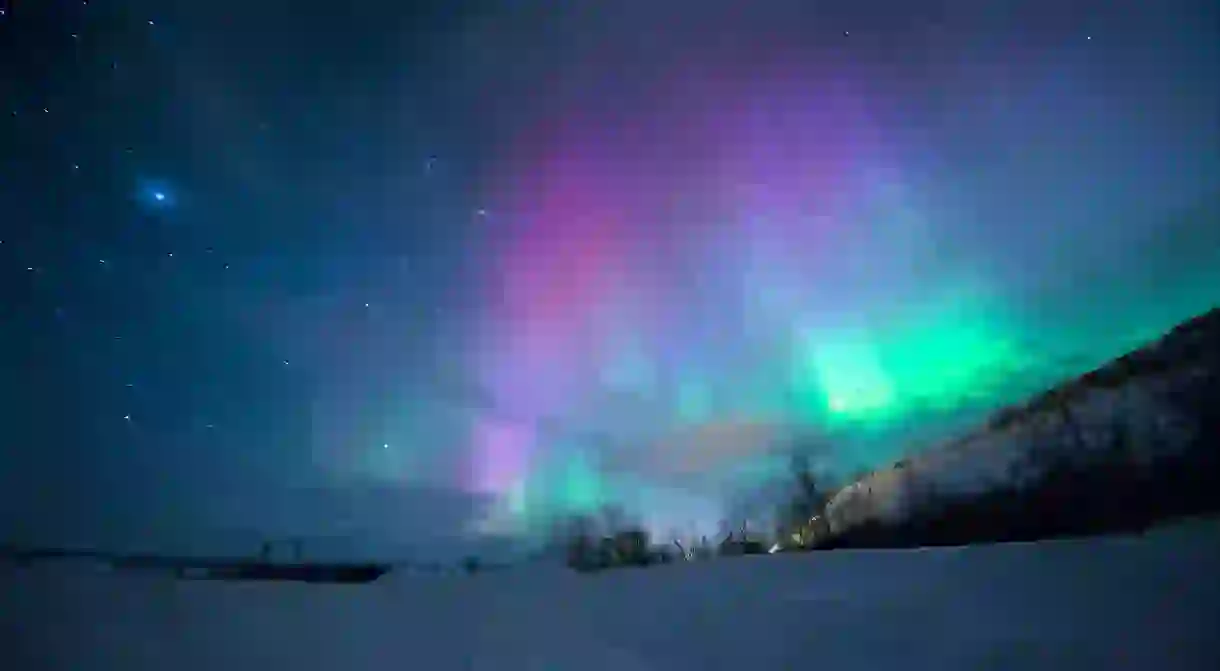A Guide to Seeing the Northern Lights in Norway

The Northern Lights (Aurora Borealis) are a phenomenon that has captured the human imagination for thousands of years. These beautiful and colourful magnetic fields feature on many people’s bucket lists, and Norway provides front row seats to this magical natural wonder.
As the name suggests, heading north is the first step to take when chasing the Lights. Secondly, timing is everything. The period between late September and late March offers the highest chance of seeing them. At that time of year, days are very short and darkness is at its most intense, helping to make the lights stand out.
Aurora Borealis requires patience. She has a mind of her own and starts the show when she wants to. The Norway Lights app for Android and iPhone provides a forecast that helps you predict the best time to see the display.
When you’re inland, many believe that cold, dry weather makes for the clearest skies, while strong winds can help to clear the skies in coastal regions. Try to avoid a full moon as its brightness can make the Lights appear paler. Bring the right equipment and make sure to wear warm, practical clothing that allows you to focus on enjoying the experience.
There is an unavoidable element of unpredictability and unreliability that comes with this ethereal display of Mother Nature’s artistry. However, nobody understands it better than those who have spent their whole life gazing up at Aurora Borealis, having been lucky enough to be born in the right part of the world. That’s why there’s a genuine appeal to following in the knowledgable footsteps of a local guide. Consider booking one of the many highly rated Northern Lights tours in Norway to take advantage of the guidance and organisation of local expert.
Northern Norway is where to head and it has numerous towns and cities that you can fly, sail or drive to with relative ease. Some of the top destinations are:
Hammerfest
Located 211km (131 mi.) north-east of the city of Tromsø, Hammerfest is among the most northerly towns in the world. Though it was burnt down during World War II, it is a lively and peaceful place today. Its extremely northern position means that summer time brings the Midnight Sun, but 24-hour daylight is no good for Aurora Borealis, so be sure to visit when Hammerfest is at its darkest. The Northern Lights tends to appear from September onwards, but your odds are increased from November through to January.
The Lofoten Islands
The Lofoten Islands form a spectacular archipelago filled with traditional fishing villages and a history dating back to the Vikings. The islands are located just below the ‘Aurora Oval’ so sightings are relatively common. There’s also something extra special about how the lights shine over bodies of water, so cosy up in a cabin in a tiny fishing village and get ready for some spectacular nighttime views. You can even head out onto the water itself, with guided activities available, like kayaking and fishing beneath the Northern Lights. Book a guided tour in the Lofoten Islands.

Lyngenfjord
This fjord is one of the driest places in Norway and boasts an 82km (51 mi.) fjord, glaciers, ravines and mountains. The landscape’s dryness, as well as the lack of light pollution – the population here is sparse to say the least – make for perfect Aurora-spotting conditions. As a popular cross-country ski touring destination, you could book a guided nighttime ski experience, or opt for a trip to the world’s northernmost whisky distillery, which has its own outdoor hot tub – ideal for enjoying the show with a wee dram.
Narvik
Narvik features the northernmost animal park in the work (Polar Park Wildlife Centre) as well as fantastic skiing opportunities and a rich Sami culture and history. It’s situated within the Aurora Oval, and its diverse microclimates – ranging from fjords to plateaus and mountains to valley – mean that even if it’s cloudy where you are, you’re likely only a short drive away from perfect viewing conditions.
Nordkapp (North Cape)
The scene of the sinking of the German battleship Scharnhorst during the World War II, the North Cape is the northernmost tip of Europe. This means that no matter how strong or weak the lights are on any given night, they’ll be visible here as long as the skies are clear (which they usually are!). We recommend the North Cape Plateau, one of the region’s most popular attractions, as the place to go and gaze above.

Svalbard
Svalbard, a giant island halfway between the northern coast and the North Pole, has more polar bears than people and is the only place on the planet where you can see the Lights in the daytime due to the intensity of the darkness during the darkest of winter. We recommend embarking on a Northern Light safari, either on a dog sled or a snowmobile, for the most truly memorable experience.
Tromsø
With a population of 72,000, Tromsø is recognised as the northernmost city in the world. The area is located in the middle of the Aurora Oval and has had people living in it since the end of the last ice age. Your chances of seeing the lights are pretty strong from September to April, and there’s something particularly striking in seeing a city lit-up by Aurora Borealis, as the Earth’s light show outshines the nighttime city lights below. Book a guided tour in Tromsø.

Vesterålen
Skiing, wildlife and art all come together in Vesterålen, which may bring you great views of not just the Aurora, but whales as well if you ask nicely. Here, the Northern Lights appear as early as mid-August and as late as mid-April.
Find out about the science behind the Northern Lights here.













